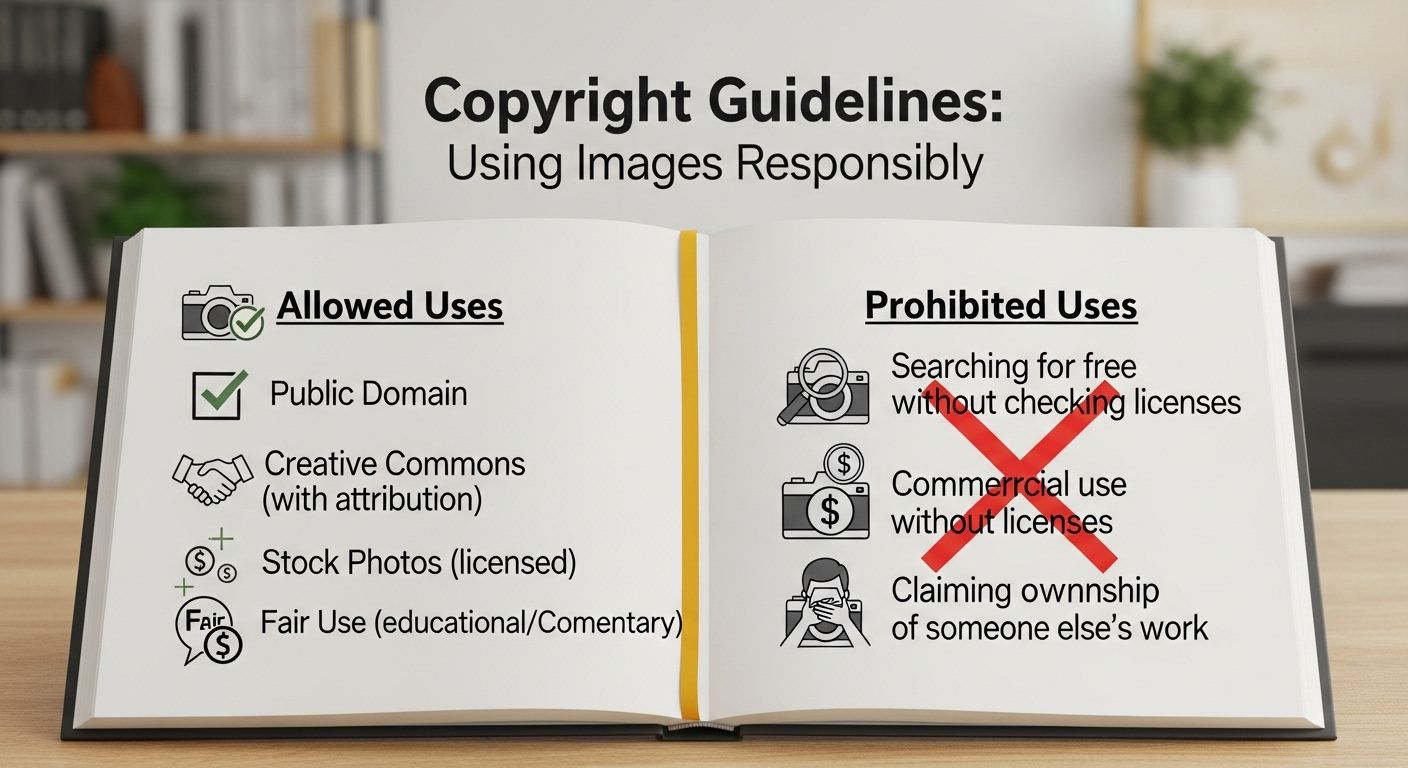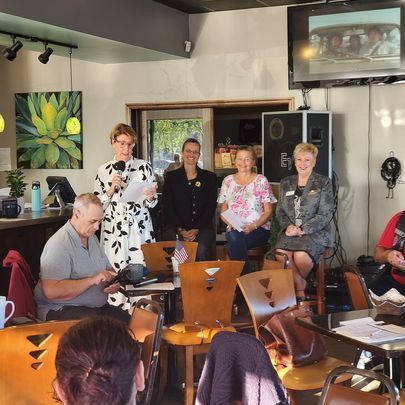A Guide to Using Photos for Business Promotion
Frank Bellizio • 19 August 2025

A Webmaster's Guide to Using Photos for Business Promotion
Disclaimer: Always assume a photo is protected by copyright unless you can prove otherwise.
Photos You Can Use Without a License/Permission
- Photos you created yourself. This is the safest and best option. If the business owner, an employee, or a paid contractor (with a "work for hire" agreement) took the picture, the business owns the copyright.
- Images from public domain sources. These are works for which the copyright has expired, been forfeited, or is inapplicable.
- Examples: U.S. government works, very old photographs (typically pre-1929 in the U.S.).
- Caution: Don't assume an image is in the public domain just because it's old. Always verify its status.
- Photos with a Creative Commons (CC) license that allows for commercial use. Creative Commons is a system of licenses that allows creators to share their work with specific conditions.
- What to look for: A CC license that includes "CC BY" (Attribution) and "CC-SA" (ShareAlike) or "CC-0" (Public Domain).
- What to avoid: Licenses with "NC" (Non-Commercial) or "ND" (No Derivatives), as these restrict commercial use and/or modifications.
- Always check the license and provide proper attribution. Many CC licenses require you to credit the creator.
- Photos from royalty-free stock photo websites. These platforms offer images that you can use for commercial purposes after a one-time payment or as part of a subscription.
- Examples: Getty Images, Shutterstock, and iStockphoto.
- Free options exist too: Sites like Unsplash, Pexels, and Pixabay are popular, but you must still check their specific terms of use to ensure commercial use is permitted.
Photos You Cannot Use Without a License/Permission
- Photos found on Google Images. The search engine simply shows you what exists; it does not grant you a license to use the image.
- Photos from other peoples' social media posts or websites. The copyright for a photo belongs to the photographer, not the social media platform. Even if a post is public, you do not have permission to download and use that image for your business. Re-sharing using the platform's native tools (like an "embed" or "repost" button) is usually acceptable, but downloading and re-uploading is almost always copyright infringement.
- Photos of celebrities or public figures found online. Even if you credit the source, you can't use a celebrity's image to promote your business without their consent and a license. This violates their "right of publicity."
- Photos with a watermark. A watermark is a clear signal that the photographer is protecting their intellectual property. Using a watermarked photo is a surefire way to get a cease-and-desist letter.
Using Photos of People for Business Promotion
This is a different, but equally important, legal consideration. While copyright protects the photographer's work, the "right of publicity" and "right of privacy" protect the individuals in the photo.
- The general rule: If you are using a photo of an identifiable person for commercial purposes (e.g., to promote a product, service, or business), you need their written permission, known as a model release. This is true even if you took the picture yourself.
- Why? Using someone's likeness for promotion could imply their endorsement of your business. Without a release, they could sue for misappropriation of their image.
- Public vs. Private Settings:
- Public places: In a public space, people generally have a reduced expectation of privacy. You can typically take and use photos for editorial or news-related purposes without a model release. However, if the photo is used for direct promotion or advertising, you still need a model release for any identifiable people.
- Private events: Even if the event is a public one (like a concert), if the person is in a private setting (e.g., in a backstage area), they have an expectation of privacy.
- Best practice: Always obtain a signed model release form from anyone who is clearly identifiable in a photo you plan to use for business promotion. For an event, you can post signs or include a clause on tickets or registration forms that states attendees may be photographed for promotional purposes.
ADDITIONAL INFORMATION
These are both very common and important questions, and they highlight the distinction between taking a photo and having the right to use it for commercial purposes.
Using an Employee's Picture
The simple and safe answer is: yes, you should have a signed release from your employee to use their picture in advertising or promotional materials.
Here's why:
- Right of Publicity: This is the key legal principle at play. The "right of publicity" gives individuals the exclusive right to control the commercial use of their name, image, and likeness.1 Even though they are an employee and you took the picture on company time, their personal identity and image still belong to them.2 Using it to promote your business (e.g., in an advertisement, on your website's homepage, or in a marketing newsletter) is considered a commercial use.3
- The "Work for Hire" Exception Doesn't Apply: While a "work for hire" agreement often grants the employer the copyright to creative work produced by an employee, it doesn't automatically transfer the employee's personal right of publicity. The photo itself may be company property, but the right to use the employee's face for advertising is a separate issue.4
- Avoiding Future Problems: Employees can leave the company. If they do, they have the right to request that you stop using their image for advertising. This can be a huge hassle and expense for you, as you may have to remove their picture from your website, brochures, and other materials.5 A signed release form (often called a "model release") protects you by granting you the perpetual right to use the photo.
Best Practice: Have a standard employee photo release form as part of your new-hire paperwork. This form should be explicit about what the photos will be used for (e.g., website, social media, brochures, etc.) and confirm that the employee consents to this use without additional compensation.
For training materials, the issue is less clear. If the photo is used strictly for internal, educational purposes and not for public promotion, you may not need a formal release. However, to be safe and to maintain a good relationship with your employees, it is always a good idea to get their consent.
Using a Picture from a Church Service or Activity
The legal and ethical considerations here are more nuanced but generally lean toward getting permission.
- Public vs. Private Space: While a church is open to the public, it is not a government-owned "public space" in the same way a park or a city street is. People inside a church service often have a greater expectation of privacy and may not want their attendance (and therefore, their religious affiliation) made public.6
- Commercial Use: Similar to the employee example, if you are using the photos to attract new members, raise funds, or promote the church as a business, that is a commercial use. In this case, you should have a release.
- GDPR and Data Privacy: In regions with strict data privacy laws like GDPR (General Data Data Protection Regulation), religious belief is considered "special category data."7 Photographing people in a religious setting and publishing the photos could be seen as processing this sensitive information, which requires explicit consent.
Best Practices for Churches and Non-Profits:
- Post Clear Signage: A simple and effective method is to place clear signs at all entrances to the church or event. The signs should state that photos and videos are being taken and may be used for promotional purposes on social media and newsletters. It should also inform people who do not wish to be photographed on how to opt out (e.g., "If you do not wish to be photographed, please see an usher for a wristband or sit in the designated 'photo-free' zone.").
- Provide an Opt-Out Option: Having a specific section or row where people can sit if they don't want to be in photos is a great way to respect privacy.8
- Focus on General Crowd Shots: Try to take wide-angle photos where individual faces are not clearly identifiable. Avoid close-ups of specific people unless you have their explicit, individual permission.
- Have a Media Policy: It is best practice for the church to have a written media policy that outlines its approach to photography and video. This policy should be available to members and visitors and could be included in the church bulletin or on its website.
- Never Post Photos of Minors Without Parental Consent: This is an absolute rule. You must get written permission from a parent or legal guardian before using a photo of a minor.
Pictures of books and items for sale.
This is an excellent question that gets to the heart of what is often called "fair use" or "fair dealing" in copyright law.
The short answer is: it depends, but it's often permissible to use a picture of a book cover for promotional or informational purposes without a license.
Here's a breakdown of the legal and practical considerations:
The "Fair Use" Doctrine
In the United States, "fair use" is a legal doctrine that allows the limited use of copyrighted material without permission from the copyright holder for purposes such as criticism, comment, news reporting, teaching, scholarship, and research.
Courts consider four factors when determining if a use is "fair":
- The purpose and character of the use: Is it for commercial purposes or for non-profit educational purposes?
- The nature of the copyrighted work: Is it a creative work (like a song) or a factual one (like a textbook)?
- The amount and substantiality of the portion used: Are you using the entire work or just a small part of it?
- The effect of the use upon the potential market for or value of the copyrighted work: Does your use of the work harm the original creator's ability to sell or license it?
Applying Fair Use to Book Covers
When you post a picture of a book cover for the purpose of recommending or reviewing it, your use is likely to be considered "fair" for a few reasons:
- Promotional and Informational Purpose: Your use is not to sell the cover itself, but to promote or comment on the book it represents. This is a transformative use of the image. The book's publisher and author would likely welcome this kind of promotion, as it helps them sell more books. Your post serves as free advertising for them.
- The Nature of the Work: A book cover is an advertisement for the book. It's designed to be shown and seen to entice people to buy the book. Unlike a full photograph or piece of art, its primary purpose is to identify and market the product.
- Minimal Harm to the Market: Using a picture of a book cover on your website or social media post does not harm the market for the book. In fact, it's likely to help it. You are not competing with the book's publisher; you are helping them.
Key Distinction:
There's a big difference between using a book cover to recommend a book and using a copyrighted image from within the book. For example, if the book contains a photograph that you download and post separately on your website, that is almost certainly copyright infringement, as it's not "fair use" and you are using a protected creative work for a purpose other than its original intent.
Best Practices
While using a book cover image is generally considered safe under fair use, here are some best practices to follow to protect yourself and your business:
- Link to the Book: Always link to the book's page on a site like Amazon or the publisher's website. This shows that your intent is to promote the book and provides a benefit to the copyright holder.
- Use the Official Image: Use the high-quality, official book cover image provided by the publisher, not a grainy photo you took with your phone or a screenshot. The publisher usually makes these images available on their website or provides them in press kits.
- Attribute Appropriately: While not always a legal requirement for fair use, it is good practice to include the book's title and author, and perhaps the publisher.
In summary, you can generally use a picture of a book's cover in a blog post or on your website when the purpose is to discuss, review, or recommend the book. This use falls under the "fair use" doctrine and is a common practice that most publishers and authors encourage.
Frank Bellizio
https://abslocalmobilemarketing.com/





